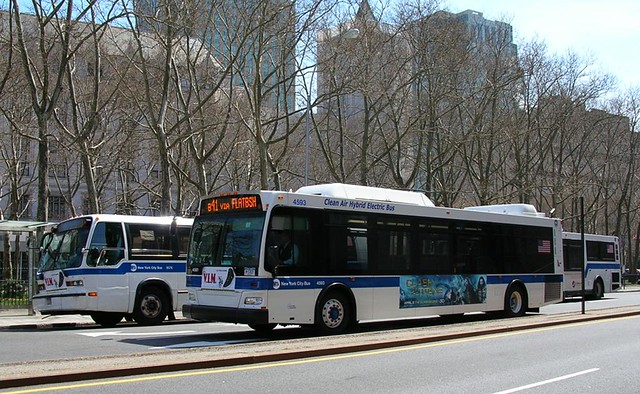
These buses are bunched intentionally at their Brooklyn Heghts terminal. (Photo by flickr user Stephen Rees)
Last week, when I left my apartment to head to work shortly after 8 a.m., I noticed a common occurrence in New York City: Despite scheduled times that allow for around 6-7 minute headways, the B67 and B69 were traveling north along 7th Ave. one on top of the other. It was a classic case of bus bunching, a problem that plagues many transit agencies and leads to complaints concerning reliability of service. Solving it has never been easy.
This week, an Atlantic Cities post by Eric Jaffe has been making the rounds, and in it, he discusses a new approach to solving bus bunching. Two professors have a “self-equalizing” way of running buses on congested city streets. Jaffe writes:
John Bartholdi III and Donald Eisenstein propose a method of bus coordination that abandons the concept of tightly-managed headways or schedules. Without the restriction of meeting pre-specified targets, drivers instead follow the flow of traffic, and natural headways emerge over time. The result is a “self-equalizing” system with less bunching and more reliability…
The system outlined by Bartholdi and Eisenstein imposes simple adjustments at control points based on an equation whose goal is to both reduce the mean headway on a line and increase overall uniformity of headways. Because the calculation operates independent of a fixed schedule, adjustments can be made at any number of control points. When systems want more headway stability, say for longer routes, all they have to do is add more control points. “The result is that headways are constantly adjusted to become more nearly equal,” the authors write…
For the study, Bartholdi and Eisenstein told drivers to abandon their schedule, ignore headways, and drive with the flow of traffic. When they reached a control point the “self-equalizing” equation computed their next departure time. Compared to average headways recorded on the same day for two weeks prior to the experiment, the new system reduced headway and increased stability
So far, this system has been tested along one 18-mile route in Chicago and on the Georgia Tech campus bus system which sees around 5000 riders per day, and the two say its working. So could this be a piece of the bus problem facing New York City? Ridership is declining because of the unreliability of service. We don’t know when the next bus is coming, and routing needs some work. But solving the bunching problem or at least alleviating it could improve the rider experience, and right now, every little bit helps.

 The New York State budgeting process is, by all accounts, a very, very messy one, and it’s even worse when the Senate is controlled by one party and the Assembly and Governorship controlled by the other. This year, with GOP lawmakers pushing for spending cuts and the MTA seeking money for its ongoing capital work, the debate over downstate dollars may turn sour. Yesterday, the New York State Senate, controlled by Republicans, voted to cut all capital subsidies for the MTA.
The New York State budgeting process is, by all accounts, a very, very messy one, and it’s even worse when the Senate is controlled by one party and the Assembly and Governorship controlled by the other. This year, with GOP lawmakers pushing for spending cuts and the MTA seeking money for its ongoing capital work, the debate over downstate dollars may turn sour. Yesterday, the New York State Senate, controlled by Republicans, voted to cut all capital subsidies for the MTA.
 As the MTA and TWU once again
As the MTA and TWU once again 














 (42nd Street Shuttle)
(42nd Street Shuttle)

